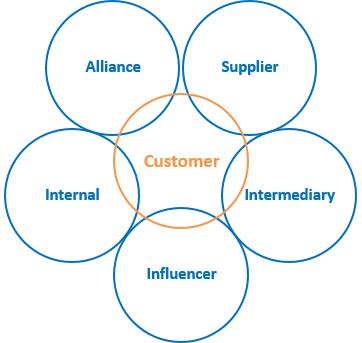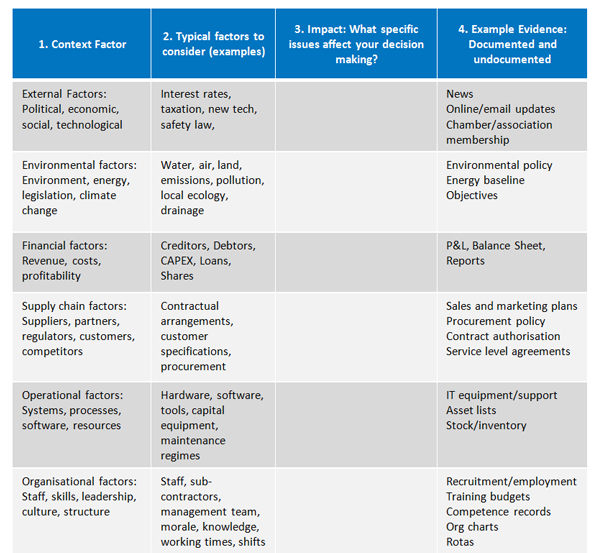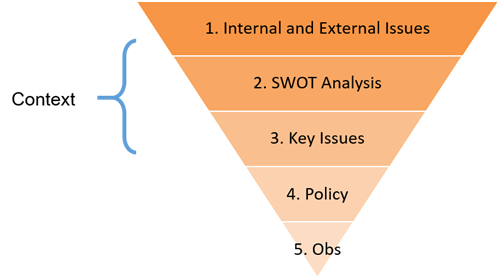Defining Context
Challenge: Understanding the organisation & its context
Why is the concept of context such a challenge? Well, context means different things to different people; it can be a transient state; it is open to interpretation; the scope of factors can be wide.
This is not a natural comfort zone for many auditors and management systems professionals and ISO 9001 recognizes this; it provides three guidance notes to understanding context:
- Note 1 confirms that positive and negative factors should be considered, which directly ties to the concept of Risk and Opportunity
- Note 2 provides some starting considerations for external analysis
- Note 3 provides limited guidance for considering internal factors such as organizational culture.
This broad guidance is useful, but the challenge remains: how to establish a process, framework or methodology for grasping this range of factors and processing them into meaningful management information.
The ability to do this will vary depending on the time, resource and skills available to undertake this activity.
Context = Scope of Management System
Context is fundamental to defining the scope of the management system. You cannot begin implementation without defining the scope of the system and that is informed by context of the organization, including the needs and expectations of interested parties.

How to Analyse internal and external issues
There are many models which can be used to identify and analyze internal and external issues. We have selected a handful which we consider useful to setting up a process and framework for defining context.
Please note that these models should be regarded as frameworks for thinking through the various aspects of context – they are not rigid structures and you can decide which features to document and act on.
-
7S Model = internal issues. Used for internal analysis including harder elements such as systems and structures and intangible elements such as management style and organizational culture.
-
PESTEL Model = external issues. Used as a framework for reviewing the macro and micro operating environment of the organization, including legal compliance obligations.
- 6 Markets Model = interested parties. Used to identify the range of stakeholders and interested parties which should be ranked in terms of their interest and influence. There is a some cross over with 7S model for staff.

METHOD 1: simple Context Review MATRIX
The Context Review Matrix provides a simple framework for reviewing the external and internal factors that create the Context of the Organization.
It is a relatively low-intensity method to start thinking about and capturing contextual information. It can be used to present your process to different stakeholders (interested parties).

Bearing in mind the above factors, you should consider:
- What are the risks and opportunities?
- Which risks and opportunities should be prioritized?
METHOD 2: Structured Context Analysis Framework
Moving to a more detailed methodology is the Context Analysis Framework.
The Context Analysis Framework links context with policy and objectives of a management system. It achieves this through strategic, tactical and operational analyses distilled into the Key Issues of the organisation.
The Key Issues define the aspects of context that influence the organisations purpose, objectives and sustainability. They also provide the input to policy making and objective setting – which may be quality, environmental, energy, safety or security objectives depending on the management system.
Context Analysis Framework:

Context Analysis Process
- Analyse and Evaluate Internal and External Issues. Use models including PESTEL, 6 Market Model, and 7S models to identify compliance obligations, interested parties, environmental and market factors.
Tip: Tabulate the headings from each model to create a bespoke matrix of identification, evaluation and prioritization based on positive and negative impact (risk and opportunity).
- SWOT analysis. Distil external factors into Strengths, Weaknesses, Opportunities and Threats (Risks and Opportunities)
Tip: refer to Section 6 of the standard for requirements on actions to address risks and opportunities.
- Key Issues: From the SWOT, identify the key issues facing the organisation i.e. the high priority issues that must be addressed in strategy, policy and objectives
Tip: Key issues can be distilled into a single sided document for reference and policy and objective setting.
- Create Policy. Document, communicate and make available a policy that addresses the key issues and commits the organization to continual improvement.
Tip: Policy is a requirement of leadership – see Section 5 of the standard for specific requirements.
- Set Objectives. Set objectives consistent with policy that are measurable, monitored and communicated. SMART objectives, quality objectives, environmental objectives etc.
Tip: Objectives are a requirement of Section 6 Planning and should meet the specific requirements stated by the standard
Summary
Understanding the context of the organisation is fundamental but manageable.
By using the methods described in this article, you should be able to develop your own framework for identifying, monitoring and reviewing context in terms of:
- External issues
- Internal issues
- Interested parties
This will enable you to demonstrate a process which clearly connects to the scope of your management system, policy and objectives.
If you have experience of using these or alternative methods, please share your knowledge to help your peers improve their management systems. Share via the blog comments below or on Twitter and LinkedIn using #ISOinnovate.
